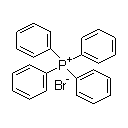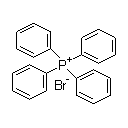Moneide Chemicals
Tel: 86-315-8309571
WhatsApp/WeChat/Mobile: 0086-15633399667
Skype: janet-honest
Mail: sales@moneidechem.com
Adresse: 2-7-523 Jidong Baumaterialien Tangshan, Hebei 064000 China
Tetraphenyl Phosphonium Bromide
|
Chemischer Name |
Tetraphenyl phosphonium bromide |
|
Synonyme |
Tetraphenyl phosphonium bromide |
|
CAS-Nr. |
2751-90-8 |
|
Summenformel |
C24H20BrP |
|
Molekulargewicht |
419.30 |
|
Molekulare Struktur |
|
|
Details |
Appearance: white solid Reinheit: 99,0 % min. |
|
Hauptanwendung |
The phase transfer catalyst in organic synthesis, suitable for synthesis between aromatic fluoride. Phosphine ylide precursor - fine chemicals, medicine, liquid crystal monomer synthesis in tichit reaction. |
- Wittig - Like Reactions: It is widely used in Wittig - like reactions, which are crucial for the synthesis of alkenes. In these reactions, Tetraphenyl Phosphonium Bromide reacts with a strong base to form a phosphonium ylide. The ylide then reacts with aldehydes or ketones, resulting in the formation of alkenes with specific double - bond positions. This reaction is highly regioselective and stereoselective, allowing for the synthesis of a wide variety of alkenes with well - defined structures. For example, in the synthesis of natural products or pharmaceutical intermediates, the Wittig - like reaction using this reagent can be used to introduce key double - bond functional groups.
- Substitution Reactions: The bromide ion in Tetraphenyl Phosphonium Bromide can be substituted by other nucleophiles. This property is valuable in the synthesis of various phosphorus - containing compounds. For instance, it can react with alkoxides, amines, or thiols to form new compounds with different functional groups attached to the phosphonium cation. These substitution reactions are important in the development of fine chemicals and specialty materials.
- Cationic Polymerization Catalyst: In polymer science, Tetraphenyl Phosphonium Bromide can act as a catalyst for cationic polymerization reactions. It can initiate the polymerization of certain monomers, such as vinyl monomers or cyclic ethers. The phosphonium cation can activate the monomer, promoting the growth of polymer chains. This is useful in the production of polymers with specific properties, such as high - molecular - weight polymers or polymers with unique architectures.
- Polymer Modification: It can also be used for polymer modification. By reacting with polymers containing reactive groups, Tetraphenyl Phosphonium Bromide can introduce new functional groups onto the polymer chains. This can change the polymer's properties, such as its solubility, adhesion, or electrical conductivity. For example, in the modification of polymers for improved compatibility in composite materials.
- Intermediate in Drug and Pesticide Synthesis: Tetraphenyl Phosphonium Bromide serves as an important intermediate in the synthesis of pharmaceutical and agrochemical compounds. In drug synthesis, it can be involved in reactions that build the complex molecular structures required for drugs. Similarly, in the synthesis of pesticides, it can participate in reactions to introduce specific functional groups that are essential for the pesticidal activity. Its use in these industries helps in the development of new drugs and pesticides with improved efficacy and selectivity.
- Tetraphenyl Phosphonium Bromide is harmful if swallowed, inhaled, or absorbed through the skin.
- It may cause skin and eye irritation. Prolonged or repeated exposure may have adverse effects on health.
- Contact with strong oxidizing agents can lead to dangerous reactions.
- When handling this product, always wear appropriate personal protective equipment, including chemical - resistant gloves, safety goggles, and a lab coat or protective apron.
- Work in a well - ventilated area, preferably under a fume hood, to avoid inhalation of dust or fumes.
- In case of contact with skin, immediately wash the affected area with plenty of water for at least 15 minutes and seek medical advice. If the compound gets into the eyes, rinse the eyes thoroughly with water for at least 15 minutes, lifting the eyelids occasionally, and then seek immediate medical attention.
- Do not eat, drink, or smoke in the area where Tetraphenyl Phosphonium Bromide is being used.
- Store Tetraphenyl Phosphonium Bromide in a cool, dry place, away from direct sunlight and heat sources.
- Keep it in a tightly sealed container to prevent moisture absorption and contact with air, which could potentially affect its chemical properties.
- Store it separately from incompatible substances such as strong oxidizing agents and acids to avoid dangerous reactions.


























